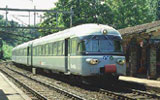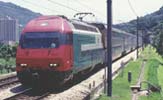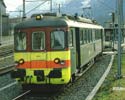 |
Tahoe
Valley Lines |
|
Honorable
Senator Joseph Biden
The Europeans built their railways too. A most significant railway extension from Turkey, thru Damascus, Syria and on to Saudi Arabia was built by Sultan Abdul Hamid early in the 20th Century. Called the Hejaz, or "Pilgrim Railway", this was a commercial venture with religious overtones, as it ran south to the Holy City of Medina. Although much was destroyed over the last 100 years of war and sabotage, parts are being restored, and the Saudis are modernizing the lines near Mecca and Medina. The "Baghdad Railway" (running to the east through Iraq, generally parallel to the mentioned Hejaz/Pilgrim line) is part of this discussion, particular to the US military predicament in Iraq. For background, see E. M. Earle, Turkey, the Great Powers, and the Baghdad Railway (1923); J. B. Wolf, The Diplomatic History of the Baghdad Railroad (1936). This is the present north-south railway running thru Baghdad, south to the Port of Basra. It is this Iraqi rail corridor that is at the heart of this Strategic Policy Proposal. The Baghdad Railway, we believe, is where the US presence in Iraq should primarily focus withdrawal strategy. This is a tangible feature of civil engineering that will change a US mistake into a Middle East Legacy. Please see the maps attached to familiarize with the two railway lines under discussion. While we cannot exactly mark rail alignment changes, additions, and expansions, we can state broad concepts. We suggest using both the "Pilgrim” and the Baghdad Railways, in a comprehensive regional solution set, to solve the Palestinian displaced persons impasse, as well as utilizing this civil engineering effort to enable an honorable conclusion for the USA military presence. Moreover, to show national good faith on the world stage, it is proposed to couple the Middle East railway solution with a similar rail transportation engineering effort in the USA, the construction of a renewable based trans-Sierra crossing, linking the capital cities of California & Nevada, Sacramento & Carson City, respectively. This will signal America's acknowledgement of 911DAY's warning regarding over reliance and national vulnerability with respect to imported oil in the transportation sector. Financial markets will reflect the morale-building aspect of America finally taking significant steps to conserve fuel, even while adding strategic Sierra transport infrastructure linked to en-route American River hydropower. It is serendipitous, to say the least, that the Honorable Lady Leader of Congress and the Gentleman Senate Majority Leader are from the two American states at the heart of this new American fuel conservation initiative. This will be advantageous in the extreme as we endeavor to gain support for a like solution from world leaders in the Middle East cauldron! II. Now, let us look at Iraq, Palestine, and the Middle East theatre. Early after 911DAY, contact was made with the US State Department, Department of Defense, as well as several diplomatic contacts and offices regarding a "Corridor Strategy" in the Iraq theater, presupposing a conflict involving US forces. Based on Moshe Dayan's precept of "The minimum required effort to achieve the minimum acceptable result", the proposed action concept would have avoided the present sort of "traffic cop/Highway Patrol" model which has presently bogged down the US effort in Iraq to the point of causing political upheaval in the US, all but bringing down the President.
The railway mode of transport was described in a circa 1955 US Army Transportation manual, "Second Dimension Surface Transport Logistics Platform", alluding to the stand-alone nature of the railway in a theater of operations/disaster-recovery scenario (NOT used in Katrina)- or, occupations force maintenance/materiel kept separate from local interference, etc. See www.peakoil.net article 374, applicable to a "Middle East Roadmap" by separation, for the most part, of civilian and military affairs, with clear-cut security zones reserved for military re-supply and traffic. In Iraq, the US ultimately shrinks to corridor protection and control (the north-south railway), linking a few bases. Further shrinkage might ultimately devolve to Kurdish territory: this to mollify Turkey, as well as maintain an effective but sharply reduced US presence.
Even as the railway strategy can be derided as too susceptible to sabotage, the fact is that no unauthorized persons would have reason to get near the operating right-of-way (subject to being fired upon), and that modern surveillance by drones, cameras and satellite can make this feasible. Everyone uses the paved roads; only the railway equipment uses the railway. Track and time authorization requirements make it very difficult for unauthorized incursions by fake maintenance personnel bent on damaging the works. This type of presence for the US permits a stand-off role, which can allow day-to-day on-call status, without daily interface with roadside bombings, snipers, etc.
Snipers are always a threat, but it is possible to protect work crews out on the line with various means of shielding, and again, the drone is above.
Israel is captive to the Palestinian presence, unless means are found to induce voluntary evacuation of populations to new locations of work and residence. US relinquishment of the railway corridor in Iraq could coincide with resettlement along this rail line of willing Palestinian family units, in a framework of allocation mindful of Shia/Sunni preferences, etc. This would have to be in context with a comprehensive quid-pro-quo involving Iran, Syria, Jordan, and the Saudis, plus other interested parties like Russia, the EU, India, etc. We save China for last, partly because they are now the world’s most prolific railroad builders, and will be just as happy dealing in railway building as well as military hardware; moreover, China will soon be the world’s largest user of Muslim oil.
This is not a perfect solution, but it allows something to be on the table, with full disclosure of the present course of events' obvious results: general war in the region and spreading. In fact. the Muslim demographics point to a constant series of wars/terrorist attacks around the world as far as the eye and imagination can scope. In the event of Iranian reluctance to participate, one can foresee the Iraq railway corridor ultimately defining the eastern frontier of the biblical promise, although one hastens to deny they ever said any such thing... In truth, however, the Muslim bent to destroy the Jewish State offers them (Islam) no safe haven in the world either! At some point, self-interest kicks in.
This railway corridor approach could be administered by a United Nations office of “Universal Postal Union”, following the 1838 Act of US Congress designating all railroads “Post Roads”, guarantors of “Societal and Commercial Cohesion in the fledgling Union of States”. This program can be further implemented worldwide, with the inclusion of renewable power sources to respective countries' rail networks, vastly expanded in capacity and reach, as part of the Peaking Oil Plan B.
III. To recap, the US problem is twofold: we must resolve our energy consumption for transport, badly unbalanced since we gave too much emphasis to the highway mode, at the expense of railways. Bringing railway capacity and reach back to proper proportion is requisite, and projects like a US50 Corridor railway project, with connectivity to places like the Port of Stockton, Monterey, Santa Rosa and North Bay points- with trans-Sierra inclusion of Carson City and Reno are just a beginning. Extrapolate concept locale by locale, across US- And, secondly, the Middle East: a solution set would include two rail corridors, the "Pilgrim" & the "Baghdad Railway" lines as basis for military pullback and Palestinian "safety valve" resettlement sites. The attached information will assist Senate and House of Representative staffers who can rework and research these several categories of tasks, in the Middle East and Stateside. Laterals or new trunk to suit military port logistics will obviously be part.of the formula. Maybe Syria gets a nice modernization ot Latakia in return for letting US materiel transit? The writers are willing to help with brainstorming around and over pitfalls and bumps. The proposals are here presented as a compendium, with the whole being greater than the sum of the parts. Nonetheless, individual aspects and features are doable stand-alone tasks. The reader is invited to see these features as part of a local benefit that translates into a regional or national benefit. For a regional example, construction of US50 corridor rail service would free track and time on the 80 (Capitol Corridor Passenger) line, even though the immediate attention is somewhat removed geographically. This, in turn, ultimately is a world demonstration that we, the USA, are willing to return to our railway roots, as an element of addressing global warming. This would most certainly help our case in the Middle East. The global implications in the Middle East are enormous: bringing renewable energy to the Oil Patch would ameliorate the deadly ambiance of feuding; it simply must take place with all due haste, as peaking oil takes hold field-by-field, even in the Muslim lands. Maryland Representative Roscoe Bartlett can help staffers on this aspect of the research. Matthew Simmons (713-236-9999), also. Note attachment from the Canadian Parliament. Our experience fifteen years ago was unanimous support for these proposals, using civil engineering as basis for bringing people together in a common cause. It is most important to give the people a vision! This goes for Americans here in the USA, as well. It is time for the feds to get going with energy and related challenges, with some WPA style investment. Thank you for your careful analysis and timely sharing of these details.
We will be honored to work with Senator Bidens' Foreign Relations staff to help craft a bi-partisan resolution that promulgates the concepts and goals herein stated. We will meet at Senator Reid's Reno/Carson City office if you wish. Thank you. Tahoe
Valley Lines
|



